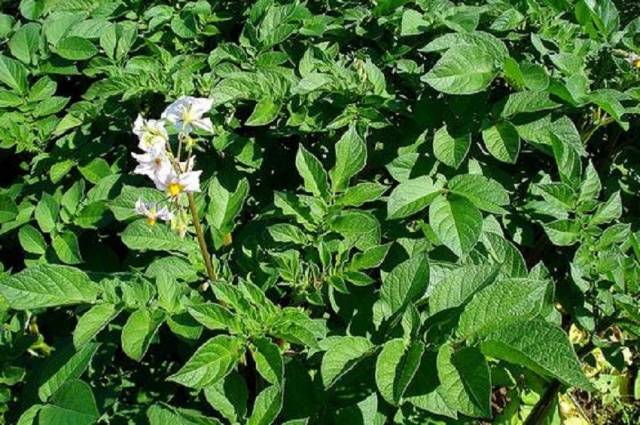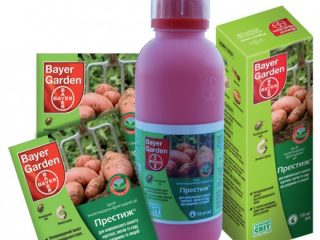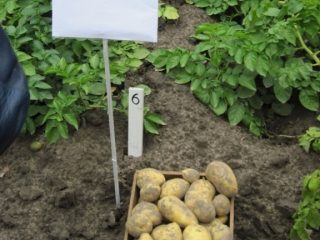Content
Each variety of potato grown by gardeners has its own characteristics. One requires strict adherence to planting dates, the other deteriorates if harvested untimely, the third is very sensitive to damage and weather fluctuations. Early ripening varieties are valued for their ability to produce tasty potatoes faster than others. The variety "Gala" is loved by vegetable growers for its unpretentiousness to the soil composition. This potato grows well in any region.
The Gala potato belongs to the mid-early variety; the short ripening period of the variety attracts vegetable growers. Harvesting can begin 75 days after it is planted in the ground. German breeders made every effort to breed the Gala potato, which made it possible to create a universal variety.
It is resistant to common crop diseases, grows in any region, produces a stable harvest, and withstands weather fluctuations. With good care, summer residents collect from 20 to 25 potatoes from one bush. Not every variety has such indicators. In our article we will try to consider the main topics for those who grow Gala potatoes - description of the variety, photos, reviews.
Description of varietal potatoes Gala
For vegetable growers, the basic characteristics of potatoes are important. These include:
- yield indicator;
- demanding care;
- varietal characteristics;
- resistance to weather conditions, diseases and parasites;
- ability for long-term storage.
To get to know the Gala potato better, you can start describing the variety with the appearance of the plant.
Bush. Semi-erect, medium height and intermediate type. The leaves on the bush are also medium in size, large, dark green, slightly wavy at the edges, allowing the plant to tolerate heat without problems. The corolla of the inflorescence is white.
Tubers. They also maintain average values in size and weight. The weight of one varies from 100 g to 120 g. The shape of the root crop is round-oval. The skin and pulp are yellowish. The eyes are superficial and small. Gala potatoes do not darken after processing. Young tubers are easy to mechanically clean, which is also considered an advantage of the variety.
The nutritional value of the vegetable is also great. The percentage of starch (up to 14%) allows the Gala potato variety to be used in dietary and baby food. Another valuable component is carotene.
Among the special advantages of the variety are resistance to nematodes and high shelf life. But the variety has some disadvantages. Potato Gala can be affected by:
- Rhizoctoniasis. This is a fungal disease that appears on the lower part of the stem. Proper preventive treatment of plants can save plantings.
- Leaf curl virus.
- Late blight of tubers. Although this trouble is very rare. Late blight of tops is more common.
The few dangers that await Gala potatoes during the growing period make it a competitive variety.
Another characteristic that brings Gala potatoes to one of the first places is high marketability. Not every variety has an indicator of 94%.
It tolerates transportation well, so farmers are happy to grow the variety in their fields.
How to properly grow a healthy variety
The first important step is purchasing seeds. Seed material is selected small in size without damage or signs of damage. Potatoes are planted a few days after the seeds are heated in the sun. The Gala potato variety is planted in the ground, deepening the tubers by 15 cm. The distance between them is maintained in the range of 75 - 80 cm. The seeds germinate together, all at the same time.
The soil requirements for the variety are low. More attention should be paid to watering and fertilizing, which will significantly increase the yield of planted material. It is optimal to add nutrition for good development of root crops:
- before boarding;
- during the second hilling period.
This technique will increase the preservation of tubers until spring.
Planting potatoes is the second important stage. To get a decent harvest, it is necessary to comply with the requirements of agricultural technology.
How to carry out this process correctly? First you need to find out the basic requirements.
The soil
If you have light sandy loam soil, you're in luck.
Although the variety adapts well to any soil, young tubers still have difficulty growing in heavy soil. Therefore, the hole produces more potatoes than usual, but smaller in size. In heavy soil, the shape of the root crops becomes uneven and the volume of waste increases during cleaning.
One ton of humus will be required per hundred square meters.
Fertilizers
The best time to nourish the soil is in the fall. Then you can add any type of organic matter - compost, humus, manure. Before spring, the substances will have time to decompose and dissolve in the ground. If you need to fertilize in the spring, anything except fresh manure will do. For 1 sq. m add from 5 to 8 kg of nutritional composition. If there is a shortage of compost, it is recommended to add it later. When is it carried out? planting potatoes, add a little compost and 1 tablespoon of wood ash to each hole.
Seed preparation
Choose medium-sized tubers for planting; small ones contain few nutrients and will not provide the root system with enough nutrition. Bring the planting material out into the light, avoiding direct sunlight. Tubers with strong sprouts, slightly green and with a thick skin are good for planting. The length of the sprouts is 1 cm. Photo of tubers ready for planting.
Dates and planting scheme
The soil temperature should rise to 10°C. This is the best option. In cold soil, tubers may rot. Be sure to follow the recommended planting pattern.
Hopes that more potatoes planted will result in an increase in yield are absolutely unfounded.Thick planting of potatoes leads to the plants oppressing each other. Planting Gala potatoes under a walk-behind tractor greatly simplifies the work of gardeners. How to properly use a walk-behind tractor when planting can be seen in the video:
Caring for Gala potato plantings
Many summer residents, having planted potatoes in the ground, believe that other activities are unimportant. First of all, this concerns the hilling of plants. Even if they carry out this technique, they do not follow the rules of hilling. The soil must be in contact with the stems of the bush, otherwise there will be no additional roots. And simply raking the soil closer to the plant does not make any sense.
Feeding is a very responsible matter. It is best to apply fertilizer in the fall or spring before planting. You should be careful with mineral compositions, especially during the growing season.
Harvesting will be more fruitful if you mow the tops on all bushes a week before it begins. The tubers stop growing and the skin becomes coarser. Gala potatoes will be ready for storage. After digging, leave the potatoes in the soil for a while to allow the sun to help kill pathogens.
Some tips for summer residents growing the variety on plots:
- Maintain crop rotation requirements. In small areas this is problematic, but you should try not to plant potatoes in one place for a long time. Another way out is to renew the seed material.
- Regularly inspect your plantings for diseases and pests. A timely start to the fight is the key to success.
- The ripening of the variety directly depends on compliance with all agrotechnical measures. Therefore, before planting, try to study the nuances of the Gala potato.
- Observe temperature and humidity levels during storage. This way, you will preserve the harvest much longer.
















